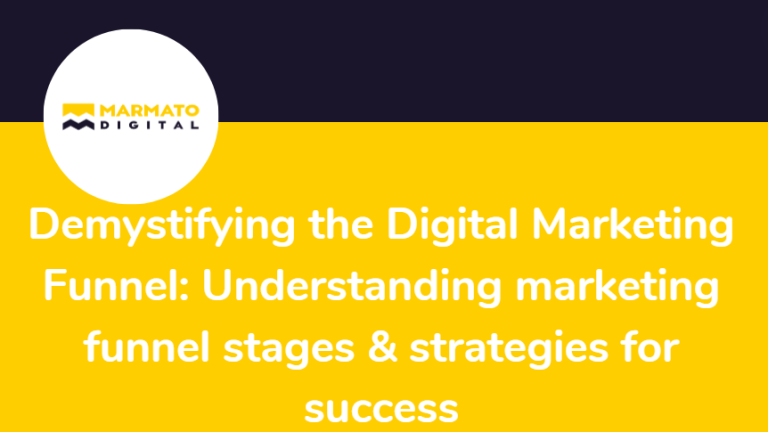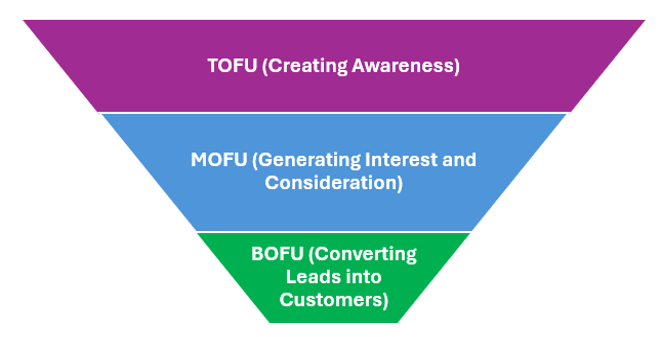A Digital Marketing Funnel is like a roadmap that guides people from being strangers to becoming loyal customers. Imagine it as a journey where people start by learning about a product or service, then become interested, and finally, they decide to buy. Each marketing funnel stage has its own purpose and strategies to help move people closer to making a purchase. Understanding how digital marketing funnel works can help businesses create effective marketing strategies to reach and convert more customers. Let’s dive in and explore the basics of the digital marketing funnel and its stages – TOFU, MOFU, and BOFU.

Understanding the Digital Marketing Funnel:
Understanding the digital marketing funnel is crucial for any business looking to succeed online. The digital marketing funnel represents a potential customer’s stages before purchasing, from initial awareness to conversion.
By grasping this concept, businesses can tailor their online marketing strategies effectively to guide customers seamlessly through each stage of the funnel. Let’s delve into the three key stages of the digital marketing funnel: TOFU, MOFU, and BOFU.

Top of Funnel (TOFU): Creating Awareness
At the top of the funnel lies TOFU marketing, also known as the awareness stage. This is where businesses aim to attract a broad audience and generate brand awareness. Strategies at this stage focus on creating valuable content that addresses the pain points and interests of potential customers without being overly promotional. Social media campaigns, blog posts, infographics, and videos are common tactics to capture attention and drive traffic.
Key characteristics of the TOFU stage:
• Problem Recognition:
Individuals in the TOFU stage begin to recognize that they have a problem or need that requires attention. This could be triggered by factors such as changes in their circumstances, external influences, or dissatisfaction with current solutions.
• Information Gathering:
During the TOFU stage, potential customers may engage in information-gathering activities to learn more about their problems or needs. They may conduct online research, seek advice from peers or colleagues, or explore relevant content and resources.
• Exploration of Options:
Individuals in the TOFU stage are open to exploring different options and approaches to addressing their problem or need. They may be considering a wide range of possibilities and may not yet have a clear preference for any specific solution.
• Awareness Building:
The primary goal of marketing efforts during the TOFU stage is to build awareness of the problem or need and to establish the brand as a relevant and trustworthy source of information. This could involve creating educational content, raising awareness through targeted advertising, or leveraging social media channels to reach a broader audience.
• Lead Generation:
While individuals in the TOFU stage may not be ready to purchase immediately, they represent potential leads that can be nurtured and guided through the rest of the buyer’s journey. Lead generation activities such as content marketing, social media engagement, and search engine optimization (SEO) play a crucial role in attracting and capturing the attention of prospects in the TOFU stage.
TOFU Success Strategies:
- Create engaging content that grabs attention and provides useful information.
- Use social media to reach a wide audience and spark interest in your brand.
- Optimize your website for search engines so people can find you easily.
- Offer free resources or incentives to encourage people to sign up for your email list.
- Use eye-catching visuals and catchy headlines to stand out from the competition.
Middle of Funnel (MOFU): Generating Interest and Consideration
Moving down the funnel brings us to MOFU marketing – the consideration or evaluation stage. Here, prospects have shown interest in your brand but may need more information before making a purchase decision. Content strategies at this stage include case studies, whitepapers, webinars, and product demos that provide in-depth information about your offerings. The goal is to build trust with leads and position your brand as a solution provider.
Key characteristics of the MOFU stage:
• Research and Evaluation:
In MOFU stage, prospects actively seek information to educate themselves about potential solutions to their problem. They may compare features, benefits, pricing, and reviews of different products or services.
• Engagement with Content:
The prospects will likely engage with content that provides in-depth information and addresses their concerns and questions. This could include case studies, product demonstrations, comparison guides, expert reviews, and testimonials.
• Interaction with Brands:
Prospects may interact with brands through various channels such as website visits, email inquiries, webinar attendance, or social media engagement. They may seek further clarification, request additional information, or express interest in learning more about a particular solution.
• Consideration of Alternatives:
During the MOFU stage, prospects actively consider multiple alternatives and weigh the pros and cons of each option. They seek evidence that a particular solution will effectively address their needs and deliver value.
• Intent to Purchase:
While prospects may not be ready to make a final purchase decision yet, they are demonstrating a clear intent to move forward in the buying process. They actively evaluate their options and narrow their choices based on their preferences and priorities.
MOFU Success Strategies:
- Provide more detailed information about your products or services to help people make informed decisions.
- Use email marketing to nurture leads and keep them engaged with your brand.
- Offer demos, free trials, or consultations to help people experience your offerings firsthand.
- Create case studies or customer testimonials to build trust and credibility.
- Use retargeting ads to remind people about your brand and encourage them to take the next step.
Bottom of Funnel (BOFU): Converting Leads into Customers
Finally, we reach BOFU marketing – the decision or conversion stage where leads are ready to purchase. At this stage, personalized content such as free trials, product comparisons, testimonials, and limited-time offers play a crucial role in encouraging conversions. The focus shifts towards closing deals by addressing specific needs and providing solutions that meet customer requirements.
Key characteristics of the BOFU stage:
• Intent to Purchase:
Prospects in the BOFU stage have a clear intent to make a purchase. They have identified their specific needs and requirements and are actively seeking a solution that meets them.
• Evaluation of Options:
Individuals in the BOFU stage may still compare different options or vendors to ensure they make the best choice. They may consider factors such as price, features, benefits, and reviews before deciding.
• Engagement with Sales Process:
Prospects in the BOFU stage are likely to engage with the sales process, whether that involves requesting a quote, scheduling a demo, or contacting a sales representative. They may have specific questions or concerns that need to be addressed before they feel comfortable moving forward.
• Final Decision Making:
The primary goal of marketing and sales efforts during the BOFU stage is to facilitate the final decision-making process and remove any remaining barriers to purchase. This could involve providing additional information or reassurance, offering incentives or discounts, or addressing objections and concerns raised by prospects.
• Conversion and Purchase:
The ultimate outcome of the BOFU stage is conversion. Here, prospects transition from being leads to becoming customers. Once a purchase decision has been made, individuals may complete the transaction online or offline, depending on the nature of the product or service.
BOFU Success Strategies:
- Make it easy for people to purchase or request more information.
- Provide clear calls-to-action (CTAs) that tell people what to do next.
- Offer incentives or discounts to encourage people to buy now.
- Provide excellent customer service to address people’s concerns or questions.
- Follow up with customers after purchase to thank them and ask for feedback.
Conclusion:
Mastering the art of digital marketing funnels is crucial for businesses aiming to succeed in today’s competitive landscape. By understanding the various stages of the funnel and optimizing each touchpoint, companies can effectively guide potential customers through the buyer’s journey.
From creating awareness to nurturing leads and driving conversions, a well-crafted digital marketing funnel is a roadmap for businesses to engage with their target audience and drive revenue growth. By leveraging data-driven insights and personalized content, companies can tailor their marketing strategies to meet the unique needs of individual customers.
Take your business to the next level with a strategic Digital marketing Funnel!
Marmato Digital can help you take your business to the next level and drive growth through a strategic digital marketing funnel. Our expert team specializes in crafting customized digital marketing strategies tailored to your business goals, whether it’s boosting brand awareness, generating leads, or driving conversions.
Let us help you navigate the complexities of the digital landscape and build strategies for each marketing funnel stage that drive sustainable growth for your business. Contact us today to schedule a consultation and discover how Marmato Digital can transform your business into a powerhouse of success.
Subscribe to Newsletter
Get our latest blogs directly to your inbox.

